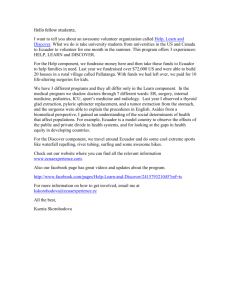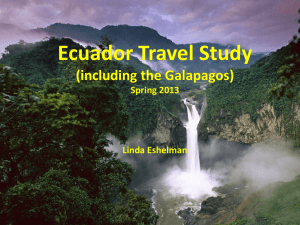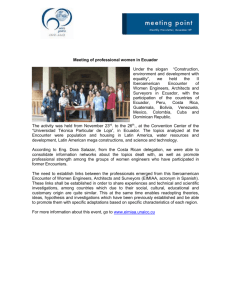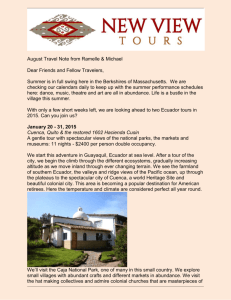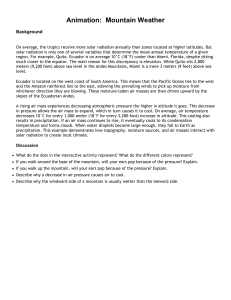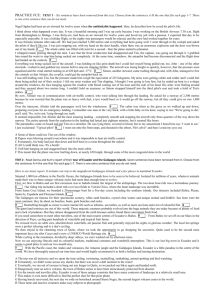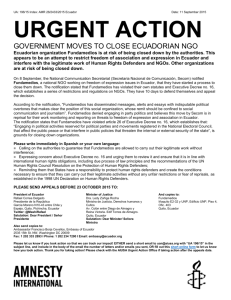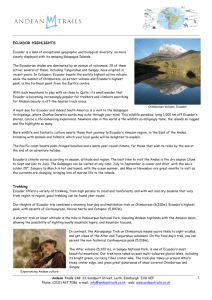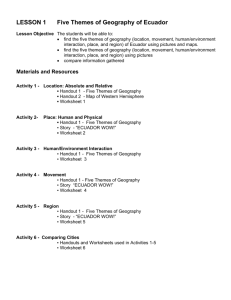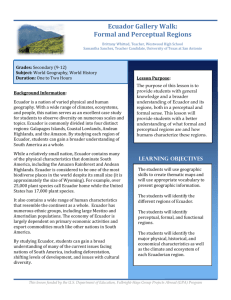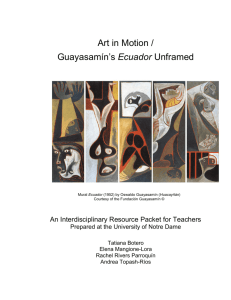ECUADOR: A Case Study
advertisement
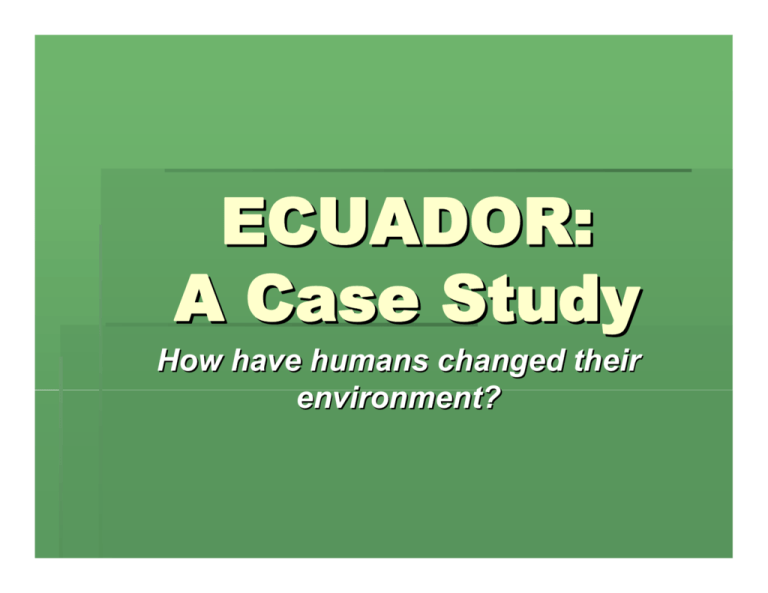
ECUADOR: A Case Study How have humans changed their environment? How have humans changed their environment? Human beings over the course of history have changed their physical surroundings to meet their many needs and wants. As technology has developed and populations have increased, humans have put more pressures on their environments, some with negative or positive consequences. Ecuador Ecuador is a country in South America, approximately the size of Colorado, that has experienced many environmental changes. The country is considered a biodiversity hotspot because it has great genetic and biological diversity. Ecuador is one of the top 20 countries with the greatest diversity in species--amazing for such a small nation. Ecuador has more diversity in plants, insects, and amphibians than the United States, a country roughly 30 times its size. The environment in all four regions of Ecuador has been affected in various ways by humans. Ecuador’s Four Regions: The Oriente, Highlands, Coast, and Galapagos Islands. The Highlands The Highlands is home to modern Quito, the capital city of Ecuador, resting 9,200 ft. above sea level in the Andes Mountain Range. With a growing population, the need for food is increasing. Much land is devoted to agriculture in Ecuador to feed its population of over 13 million. The main crops include rice, corn, potatoes, and soybeans. A potato field Terraced land outside Quito Typical Highland food includes beef, potatoes, corn, and even fried Guinea Pig. Rose plantations are a booming business in Ecuador. Large, irrigated greenhouses allow roses of all varieties to mature for one year before being packaged and transported by truck to Quito for export. A young woman picking roses Man responsible for applying pesticides to the roses. Cuenca is Ecuador’s second largest city in the Highlands behind Quito. It was colonized by the Incas and then by the Spanish in the 1500s. It has kept much of its European colonial architecture. One of Cuenca’s busy streets. The Andes are visible in the background. Families do laundry in one of the four major rivers that run through Cuenca. The Coast The coast is a very diverse region home to Ecuador’s largest city of Quayaquil, vast agricultural lands, and coastal resources. A view of the crowded port city of Quayaquil. Irrigated Banana Plantation Ecuador’s agricultural center is in the coastal region. Many crops are grown including bananas, one of Ecuador’s largest exports. A cacao fruit--What chocolate is made of! Bananas Fishing is very common along the coast. There are also many shrimp, tilapia, and crab farms built along the coast. Often mangrove forests have been destroyed to make room for aquaculture. A fisherman checking his nets A bundle of captured crabs The Oriente Within Ecuador’s territory lies part of the Amazon Basin. Since the 1960s more people have moved to the Oriente causing many environmental challenges. Environmental Issues Include: Deforestation Habitat Destruction Mining Hunting Oil Excavation A new road winds from the Andes into the Amazon. The building of roads has encouraged more settlers to relocate to this region, intensifying environmental concerns. After oil was discovered in Ecuador in 1969, the government leased blocks of land to oil companies. Few environmental laws exist or are enforced, so much environmental damage has occurred from the excavation of oil. The indigenous people and oil companies have clashed over land rights. Also, many people have developed health problems due to exposure to the oil, causing more conflict. A pipeline from the Amazon to the Pacific Ocean. More tourists are coming to the Amazon as more roads and airports are making it easier for them to reach the region. People from across the world come to experience the Amazon and meet its people. A hiking trip with local guides Learning to shoot a blow gun from a local hunter The Galapagos Islands A friendly sea lion The Galapagos Islands are world famous for being home to many endemic speciesor species that are found no where else on the planet. A giant tortoise can live to be 150 years old. Their population was threatened by sailors who kept them alive for up to one year without food aboard so they would always have fresh meat. A blue-footed boobie The islands are 600 miles from mainland Ecuador so they have been largely protected from human interference until recently. Today the human population is growing quickly--26,000 people live on the islands now. A Marine Iguana--It is the only iguana in the world that can live on land and in the water. It can swim 60 feet deep and hold its breath for up to an hour. A colorful crab! Providing basic needs for people including transportation (roads, airports, cars, boats), housing, and waste management have caused damage to the environment. Also, new species, like goats and cats, that endanger Galapagos species have been accidentally introduced by people. Thousands of tourists from around the world visit every year. Some stay on land while others stay on cruise boats that travel island to island. Sea lions lounge on the boats of local fishermen and women. People in the United States have also changed their environment. Windmills for energy outside of Palm Springs, California. The Imperial Dam in California, controlling the flow of the Colorado River for downstream consumption. Humans have and will continue to change their environment. Today we must STOP and THINK how we can make more responsible changes with fewer negative consequences on our environment. Ski chairlift at Mammoth Resort, California. Irrigated Fields of Yuma, Arizona.
